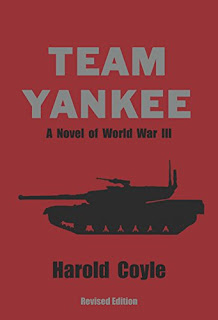Book Review: 'Team Yankee: A Novel of World War III'
 |
| (C) 1987 Presidio Press |
Harold Coyle's Team
Yankee: A Novel of World War III (Presidio Press, 1987) was published a
year after Tom Clancy’s Red Storm
Rising's triumphant debut in hardcover. Although it is thematically
similar (Soviet forces invade West Germany after a series of crises escalate
into an all-out conventional war), Coyle's approach is very different from
Clancy's. Instead of creating his own possible scenario for a NATO vs. Warsaw Pact
confrontation, he asked for, and received, permission from British author (and
retired General) Sir John Hackett to set Team Yankee within the scenario
created in Hackett's two "speculative fiction" books The Third World War: August 1985 and The Third World War: The Untold Story.
Team Yankee takes place within a two-week period in an August in the late 1980s. Since late July, a series of crises precipitated by the Iran-Iraq war has morphed into a clash between U.S. and Soviet naval forces in the Persian Gulf region. By August 1, word comes that NATO is mobilizing and ordering their armed forces, including Bannon and Team Yankee, to their wartime positions.
Team Yankee takes place within a two-week period in an August in the late 1980s. Since late July, a series of crises precipitated by the Iran-Iraq war has morphed into a clash between U.S. and Soviet naval forces in the Persian Gulf region. By August 1, word comes that NATO is mobilizing and ordering their armed forces, including Bannon and Team Yankee, to their wartime positions.
Soon, the Soviets and their Warsaw Pact "allies"
cross the Inner German Border in force. Team Yankee and the rest of NATO's
forces in West Germany must then fight the invaders and stop them before the
Red Army reaches the Rhine River. After that, assuming the Soviet attack bogs
down, the mission will change from merely defending territory to taking offensive
operations and pushing the invaders back. The question Coyle poses is, can
American soldiers, using their weapons and tactics against superior numbers of
Soviet and Warsaw Pact soldiers, defeat Russian weapons and tactics?
Bannon snapped his head to the left. There was
no need to use a map. There was only one place where the Russians would be, and
that was on the hill 2,200 meters away. All the training, planning, and
preparation was over. Team Yankee was about to learn if the Team’s seventy-nine
men and twenty-five million dollars’ worth of equipment could do what they were
supposed to do: close with and destroy the enemy by fire, maneuver, and shock
effect.
The five T-72 tanks began their descent into the
valley in a line with about 100 meters between tanks. One of them had a mine
roller attached to the front of its hull. He would have to be taken out in the
first volley.
As soon as the tanks started down, a line of
Soviet armored personnel carriers, BMP-2s, appeared on the crest of the hill
and followed the tanks down without hesitation. There were fifteen of these
personnel carriers deployed in a rough line about one hundred meters behind the
tanks. All moved down the opposite slope at a steady and somewhat restrained
pace, as if they really didn’t want to go into the valley or get too far ahead
of follow-on elements.
The scene before Team Yankee was too good to be
true. For some unknown reason the Team had not been hit by artillery yet. The
Soviets were rolling forward as if they were on maneuvers, not attacking an
enemy force hunkered down in prepared positions. Even better, their change in
direction offered most of the Team flank shots. And on top of that, the actions
by the command group had telegraphed who they were. If luck held for another
minute or two, it would be all over for this motorized rifle battalion.
“ROMEO 83, THIS IS ROMEO 25. DO YOU SEE THAT
LAST GAGGLE COMING DOWN THE HILL? OVER.”
“25, THIS IS 83. ROGER, OVER.”
“83, THIS IS 25. THAT IS THE COMMAND GROUP. I
WANT YOU AND THE TWO TRACKS YOU HAVE UP THERE TO TAKE THEM OUT. THE BMP AND
TANK FIRST, OVER”
“THIS IS 83, WILCO.”
Readers familiar with Hackett's macrocosmic World War III will know the big picture, but first-time readers will be turning the pages to see who wins, who loses, who dies...and who survives in this outstanding first novel by a true master of the military fiction genre.
The only flaw, and this is not Coyle's fault, is that reality -- in the shape of the fall of communism and the end of the Cold War -- has made the novel's setting extremely outdated. Some of the then-modern weapons, such as the M1 main battle tank, have been since updated to M1-A2 standard, older weapons have been retired, and obviously there's no more Warsaw Pact.
All in all, it's an entertaining read.

.jpg)

Comments
Post a Comment